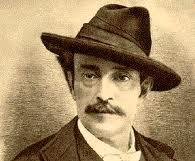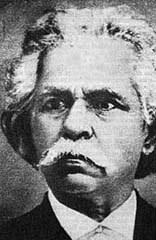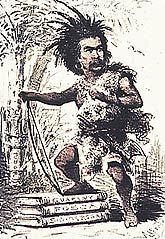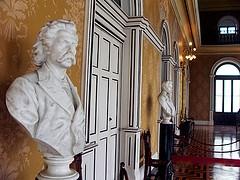All these pressures only served to exacerbate Gomes’ growing despondency over his lot. The one hope he had for resurrecting his career was anchored in the mistaken belief that his past and current associations with greatness would lead to greatness rubbing off.

Poet & librettist Antonio Ghislanzoni (members.xoom.virgilio.it)
Although some of Verdi’s own librettists — Antonio Ghislanzoni and Arrigo Boito being the most well-known — supplied texts or revisions to several of Gomes’ works, in the long run they did nothing to help earn his operas a permanent place in the standard repertoire. Furthermore, the composer’s work habits were often erratic, as a peremptory burst of enthusiasm for a subject would give way to complete abandonment of the idea soon after.*
Poet and playwright Ghislanzoni, a former neighbor and frequent collaborator, pictured the tormented Brazilian as “full of enthusiasms and disappointments, impulses and uncertainties, noble intentions and unjustified insecurities so typical of the irreconcilable attitude of one who struggles to produce a masterpiece.” This was an exceptionally accurate portrait.
He went on to describe his friend’s compulsive obsession with public opinion, which had an unusually negative effect on his writing, and with what potential reviewers had to say about his works in general.
Gomes had every reason to be concerned. Although they were popular in their day, the quality of the music to be found in many of his scores was inconsistent and derivative, what one modern critic (referring to Guarany) labeled “a clichéd stew of Verdian heroics and Donizettian flightiness,” and another termed “Bellini without tunes, Rossini without wit.”
These may seem like unduly harsh statements, but they are not far from the mark. For, as we have seen, Gomes chose as his musical models the operas of early- and middle-period Verdi; spiced with the unwieldy five-act opuses of Meyerbeer, whose oeuvres were already considered passé just as the composer approached his creative prime; and topped them off with a dash of Wagnerian leitmotif, for which he was severely taken to task by the press — ironic, in that he was often accused of being old-fashioned and out-of-touch with the musical mainstream.

Carlos Gomes, in his later years (renatacortezsica.com.br)
Gomes was soon eclipsed, if not entirely overshadowed, by the mature Verdi’s late career output, which included the aforementioned Aida and Otello along with the Requiem Mass (1874) and Falstaff (1893). There was also a whole new stylistic form called verismo (“realism”) to contend with and new challengers on the Italian front to defend against, among them Pietro Mascagni (Cavalleria Rusticana, 1890), Ruggero Leoncavallo (Pagliacci, 1892), Alfredo Catalani (La Wally, 1892), and the up-and-coming Puccini, whose Manon Lescaut caused a sensation at its 1893 premiere in Turin, which Gomes attended.
While it may only be partially true that his imagination was set free by specifically Brazilian-related themes and ideas, Gomes did manage to derive a certain status, if one could call it that, as a composer of Italian opera, despite the presence of so many of Europe’s finest talents.
It was not so much feelings of inferiority that finally did Gomes in, so to speak, as that of the quality of the competition. History eventually relegated the campineiro to a position not unlike that of Viennese court composer Antonio Salieri vis-à-vis the extraordinary body of work produced by that sublime musical genius, Wolfgang Amadeus Mozart. Overall, his situation proved much closer to Herr Mozart’s than to either Salieri’s or Verdi’s, in that, post-Guarany, he managed to retain a respectable enough portion of his earnings to have led a fairly modest lifestyle, but was unable to resist spending it all on his lavish estate and for mere appearances’ sake.
If only Gomes had learned to master his emotions; if only he had been blessed with a few more years of robust health and creativity; if only he had better managed his affairs, both personal and financial; if only he had been given a lower quotient of inferior libretti to work with; and, most emphatically of all, if only the opera world (and his fellow Brazilians) had insisted on treating him equitably and with a degree of equanimity, then perhaps the performance history of his works might today be different from that which we already know.
Bye-Bye, Belém
Poor timing and equally bad luck would continue to badger the unfortunate composer all the way back to his native land. In fragile health from years of neglect; battered by bouts of depression over the earlier deaths of three of his five children, intermittently relieved by the liberal ingestion of opium and laudanum; and constantly hounded by creditors, the “man who would be Verdi” came back to Brazil one last time, in May of 1896, to assume the directorship of the Belém Conservatory in Pará, at the mouth of the Amazon River, which for him was a personal and artistic nadir compared to his previous triumphs.
“If my ailment means the death of me,” he was quoted as saying just before he abandoned the Continent for good, “then I’d rather my death be in Brazil.”
* * *
Antonio Carlos Gomes got his wish: he passed away of throat cancer on September 16, 1896, only four months after he took up his post and in the same year that opera was about to delight in a decade-long rebirth in the region. He was 60 years old, but his legacy would forever be assured as the first and only internationally recognized composer of Brazilian national opera the country would ever produce; and the first of his musical line to truly make Brazil’s Fat Lady sing.
Writer Rubem Fonseca, author of the fiction novel O Selvagem da Ópera (“The Savage of the Opera”), sagaciously reminds us, in his Sisyphean account of the composer’s turbulent life, that “…the savage Brazilian maestro did not do a savage opera… [F]rom the moment that he writes an opera, a savage artist stops being a savage. Antithetically, Carlos Gomes wants to be recognized as a great musician, in his country and in the ‘civilized world’: so becoming a European artist is the fastest and safest way of achieving what he wishes.”

Gomes as “Ibere” (Veja Magazine)
The November 1889 issue of the publication Veja na História was printed not five days after the Proclamation of the Republic. It featured a period caricature of the composer as Iberê, the hero of Lo Schiavo (“The Slave”). Here, as his contemporaries envisioned him, was the “great musician” in full jungle attire: portrayed as a Tarzan-like creature in flowing dark mustaches, he is dressed in animal skins, with a bow in his right hand and a sword at his side, his thick, matted hair standing straight on end. His feet are bare and his right leg rests atop several large volumes of his vocal scores — Gomes the “slave,” in all his finery, neither completely Brazilian nor fully European.
One thinks of Verdi’s Iago, sarcastically barking the line, “Ecco il Leone!” – “Behold the Lion!” over the prostrate body of the former slave-turned-general Otello. Only here, Gomes is upright, yet his fall from grace is no less pronounced. Despite a lifetime spent in the “civilized world” of the theater, the “Italian” composer from Campinas never ceased being a “savage Brazilian maestro” — even after eight completed operas, two musical revues, and a symphonic poem with chorus, in addition to numerous chamber works, art songs, orchestral music, as well as sacred and salon pieces.
In contrast to how he was depicted in life, a beautiful marble bust of Gomes, sculpted by the Genovese artist Achille Canessa, reposes in the great hall of the Teatro da Paz Opera House, in the northern city of Belém, as a posthumous tribute to the man and his works. It occupies an august spot next to the bust of a relatively unknown fellow composer named Henrique Eulálio Gurjão.
The irony of juxtaposing the perceived greatness of a Carlos Gomes with the almost total obscurity of an Henrique Gurjão cannot be lost on the casual viewer: of course, Gomes towers head and shoulders above his unfamiliar countryman; but he stumbles ever so markedly — and so utterly — before the likes of Verdi, Puccini, Donizetti, and Bellini.

Bust of Gomes, left (Photo: Andressa Silva, All rights reserved)
We need only to be reminded of the ephemeral quality of fame and of how truly fleeting the memory of a great artist can be when compared to that of his peers. ☼
(End of Part Five)
Copyright © 2013 by Josmar F. Lopes
* Some of the more elaborate titles Gomes was known to have worked on included: Emma di Catania, Oltrada, Palmira, Os Mosqueteiros do Rei (“The King’s Musketeers”), Marinella, Morena, O Cântico dos Cânticos (“The Canticle of Canticles”), Gli Zingari (“The Gypsies”), Eros, Moema, Leona, Ninon de Lenclos, and Kaila. All were left untouched or unfinished at his death.

